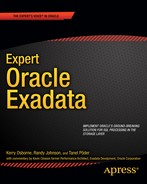Contents
Alternative Views of What Exadata Is
![]() Chapter 2: Offloading / Smart Scan
Chapter 2: Offloading / Smart Scan
How to Verify That Smart Scan is Happening
Performance Statistics (v$sessstat)
![]() Chapter 3: Hybrid Columnar Compression
Chapter 3: Hybrid Columnar Compression
Moving Data to a non-Exadata Platform
Disabling Serial Direct Path Reads
Special Optimization for Nulls
Physical Distribution of Values
Incompatible Coding Techniques
![]() Chapter 5: Exadata Smart Flash Cache
Chapter 5: Exadata Smart Flash Cache
![]() Chapter 6: Exadata Parallel Operations
Chapter 6: Exadata Parallel Operations
Parallelization at the Storage Tier
Parallel Statement Queuing Wrap Up
![]() Chapter 7: Resource Management
Chapter 7: Resource Management
The Wait Event: resmgr: cpu quantum
Configuring and Testing Instance Caging
Methods for Managing I/O on Exadata
![]() Chapter 8: Configuring Exadata
Chapter 8: Configuring Exadata
About the Configuration Process
Step 1: The Configuration Worksheet
Step 3: Upload Parameter and Deployment Files
Step 6: Staging the Installation Media
Upgrading the Existing Cluster
Backing Up the Database Servers
Exadata Optimizations for RMAN
![]() Chapter 10: Exadata Wait Events
Chapter 10: Exadata Wait Events
Plan Steps That Trigger Events
Exadata Wait Events in the User I/O Class
cell single block physical read
cell list of blocks physical read
Exadata Wait Events in the System I/O Class
cell smart restore from backup
Exadata Wait Events in the Other and Idle Classes
enq: KO—fast object checkpoint
![]() Chapter 11: Understanding Exadata Performance Metrics
Chapter 11: Understanding Exadata Performance Metrics
Measuring Exadata's Performance Metrics
Revisiting the Prerequisites for Exadata Smart Scans
Exadata Smart Scan Performance
Understanding Exadata Smart Scan Metrics and Performance Counters
Exadata Dynamic Performance Counters
When and How to Use Performance Counters
The Meaning and Explanation of Exadata Performance Counters
Exadata Performance Counter Reference
Understanding SQL Statement Performance
![]() Chapter 12: Monitoring Exadata Performance
Chapter 12: Monitoring Exadata Performance
Monitoring SQL Statement Response Time
Monitoring SQL Statements with Real-Time SQL Monitoring Reports
Monitoring SQL Statements using V$SQL and V$SQLSTATS
Monitoring the Storage Cell Layer
Accessing Cell Metrics in the Cell Layer Using CellCLI
Accessing Cell Metrics Using the Grid Control Exadata Storage Server Plug-In
Monitoring Exadata Storage Cell OS-level Metrics
![]() Chapter 13: Migrating to Exadata
Chapter 13: Migrating to Exadata
Copying Data over a Database Link
Transportable Tablespaces (and XTTS)
Wrap Up Physical Migration Section
Creating FlashDisk-Based Grid Disks
Configuring ASM-Scoped Security
Configuring Database-Scoped Security
![]() Chapter 15: Compute Node Layout
Chapter 15: Compute Node Layout
![]() Chapter 16: Unlearning Some Things We Thought We Knew
Chapter 16: Unlearning Some Things We Thought We Knew
Exadata Smart Flash Cache (ESFC)
Write-Intensive OLTP Workloads
Things that Can Cripple Smart Scans
Sending Commands from the Operating System
Configuring and Managing the Storage Cell
![]() Appendix B: Online Exadata Resources
Appendix B: Online Exadata Resources
Helpful Exadata MOS Support Notes
